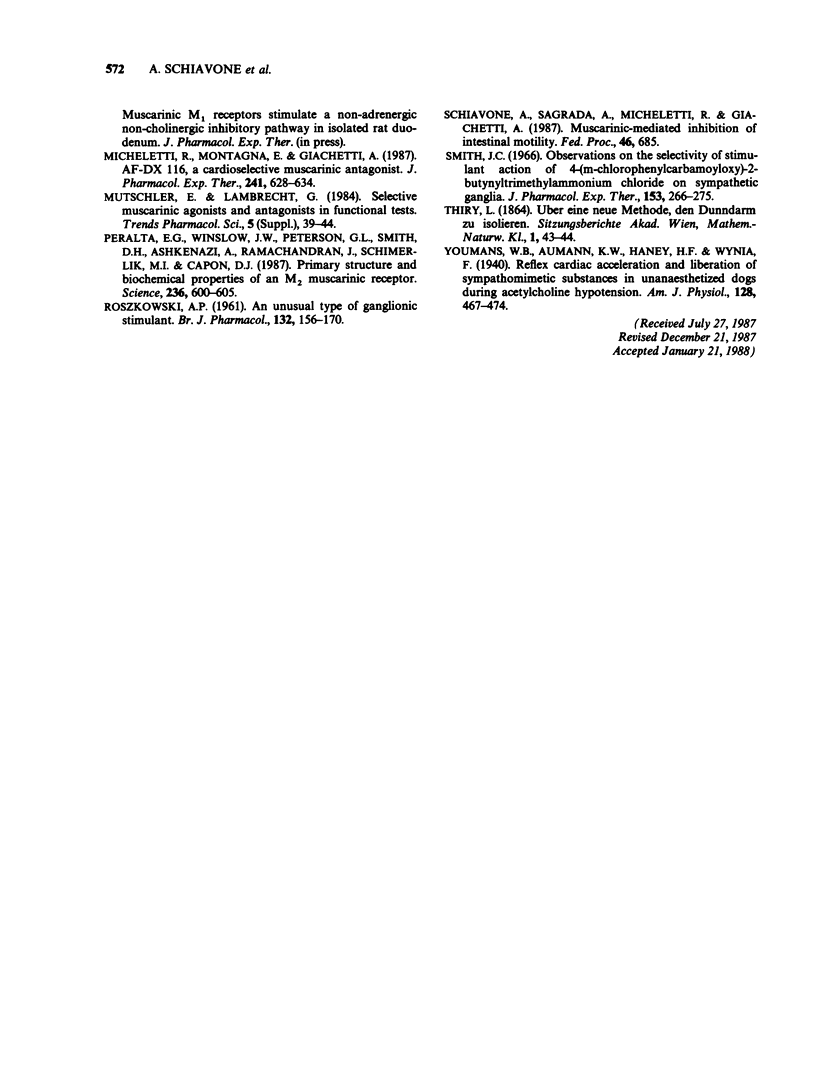Abstract
1. Intravenous injection of the muscarinic agonist, McN-A-343, in conscious dogs equipped with an ileal Thiry fistula produced a dose-related inhibition of intestinal phasic contractile activity, and an increase in heart rate. 2. The inhibitory action of McN-A-343 on motility was antagonized with different potencies by antimuscarinic drugs. The non-selective drug, N-methylatropine, blocked the McN-A-343 effect as well as the reflex phasic activity. The M1-selective compound, pirenzepine (1-30 micrograms kg-1), was a potent antagonist of the McN-A-343 effect, whereas the cardioselective M2-antagonist, AF-DX 116, and the smooth muscle selective compound, 4-diphenylacetoxy-N-methyl piperidine (4-DAMP), were completely ineffective at the doses tested. 3. The McN-A-343-induced inhibition of intestinal motility was blocked by locally applied lignocaine, suggesting the involvement of a neural inhibitory pathway. The resistance to hexamethonium and (alpha 1-, alpha 2- and beta-) adrenoceptor blocking drugs excluded transmission through a nicotinic synapse or release of catecholamines. 4. McN-A-343-induced tachycardia was also the result of muscarinic receptor activation. It was very sensitive to antagonism by 4-DAMP, while being completely unaffected by AF-DX 116. Pirenzepine displayed an intermediate profile, reducing tachycardia at doses fully active in reversing the agonist-mediated effect on intestinal motility. Propranolol partially reduced McN-A-343 tachycardia, suggesting catecholamine release. 5. The two McN-A-343 effects investigated in the present study appear to be mediated by different muscarinic receptor subtypes.(ABSTRACT TRUNCATED AT 250 WORDS)
Full text
PDF






Selected References
These references are in PubMed. This may not be the complete list of references from this article.
- Barlow R. B., Berry K. J., Glenton P. A., Nilolaou N. M., Soh K. S. A comparison of affinity constants for muscarine-sensitive acetylcholine receptors in guinea-pig atrial pacemaker cells at 29 degrees C and in ileum at 29 degrees C and 37 degrees C. Br J Pharmacol. 1976 Dec;58(4):613–620. doi: 10.1111/j.1476-5381.1976.tb08631.x. [DOI] [PMC free article] [PubMed] [Google Scholar]
- Carlson G. M., Ruddon R. W., Hug C. C., Jr, Bass P. Effects of nicotine on gastric antral and duodenal contractile activity in the dog. J Pharmacol Exp Ther. 1970 Apr;172(2):367–376. [PubMed] [Google Scholar]
- Eglen R. M., Kenny B. A., Michel A. D., Whiting R. L. Muscarinic activity of McN-A-343 and its value in muscarinic receptor classification. Br J Pharmacol. 1987 Apr;90(4):693–700. doi: 10.1111/j.1476-5381.1987.tb11222.x. [DOI] [PMC free article] [PubMed] [Google Scholar]
- Eglen R. M., Whiting R. L. Muscarinic receptor subtypes: a critique of the current classification and a proposal for a working nomenclature. J Auton Pharmacol. 1986 Dec;6(4):323–346. doi: 10.1111/j.1474-8673.1986.tb00661.x. [DOI] [PubMed] [Google Scholar]
- Fox J. E., Daniel E. E., Jury J., Robotham H. Muscarinic inhibition of canine small intestinal motility in vivo. Am J Physiol. 1985 May;248(5 Pt 1):G526–G531. doi: 10.1152/ajpgi.1985.248.5.G526. [DOI] [PubMed] [Google Scholar]
- Giachetti A., Micheletti R., Montagna E. Cardioselective profile of AF-DX 116, a muscarine M2 receptor antagonist. Life Sci. 1986 May 5;38(18):1663–1672. doi: 10.1016/0024-3205(86)90410-8. [DOI] [PubMed] [Google Scholar]
- Gilbert R., Rattan S., Goyal R. K. Pharmacologic identification, activation and antagonism of two muscarine receptor subtypes in the lower esophageal sphincter. J Pharmacol Exp Ther. 1984 Aug;230(2):284–291. [PubMed] [Google Scholar]
- Goyal R. K., Rattan S. Neurohumoral, hormonal, and drug receptors for the lower esophageal sphincter. Gastroenterology. 1978 Mar;74(3):598–619. [PubMed] [Google Scholar]
- Hammer R., Berrie C. P., Birdsall N. J., Burgen A. S., Hulme E. C. Pirenzepine distinguishes between different subclasses of muscarinic receptors. Nature. 1980 Jan 3;283(5742):90–92. doi: 10.1038/283090a0. [DOI] [PubMed] [Google Scholar]
- Hammer R., Giachetti A. Muscarinic receptor subtypes: M1 and M2 biochemical and functional characterization. Life Sci. 1982 Dec 27;31(26):2991–2998. doi: 10.1016/0024-3205(82)90066-2. [DOI] [PubMed] [Google Scholar]
- Hammer R., Giraldo E., Schiavi G. B., Monferini E., Ladinsky H. Binding profile of a novel cardioselective muscarine receptor antagonist, AF-DX 116, to membranes of peripheral tissues and brain in the rat. Life Sci. 1986 May 5;38(18):1653–1662. doi: 10.1016/0024-3205(86)90409-1. [DOI] [PubMed] [Google Scholar]
- Korc M., Ackerman M. S., Roeske W. R. A cholinergic antagonist identifies a subclass of muscarinic receptors in isolated rat pancreatic acini. J Pharmacol Exp Ther. 1987 Jan;240(1):118–122. [PubMed] [Google Scholar]
- Kubo T., Fukuda K., Mikami A., Maeda A., Takahashi H., Mishina M., Haga T., Haga K., Ichiyama A., Kangawa K. Cloning, sequencing and expression of complementary DNA encoding the muscarinic acetylcholine receptor. Nature. 1986 Oct 2;323(6087):411–416. doi: 10.1038/323411a0. [DOI] [PubMed] [Google Scholar]
- Kubo T., Maeda A., Sugimoto K., Akiba I., Mikami A., Takahashi H., Haga T., Haga K., Ichiyama A., Kangawa K. Primary structure of porcine cardiac muscarinic acetylcholine receptor deduced from the cDNA sequence. FEBS Lett. 1986 Dec 15;209(2):367–372. doi: 10.1016/0014-5793(86)81144-9. [DOI] [PubMed] [Google Scholar]
- Micheletti R., Montagna E., Giachetti A. AF-DX 116, a cardioselective muscarinic antagonist. J Pharmacol Exp Ther. 1987 May;241(2):628–634. [PubMed] [Google Scholar]
- Peralta E. G., Winslow J. W., Peterson G. L., Smith D. H., Ashkenazi A., Ramachandran J., Schimerlik M. I., Capon D. J. Primary structure and biochemical properties of an M2 muscarinic receptor. Science. 1987 May 1;236(4801):600–605. doi: 10.1126/science.3107123. [DOI] [PubMed] [Google Scholar]
- ROSZKOWSKI A. P. An unusual type of sympathetic ganglionic stimulant. J Pharmacol Exp Ther. 1961 May;132:156–170. [PubMed] [Google Scholar]


